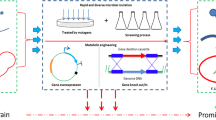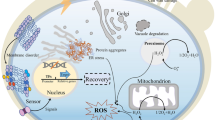Abstract
In the present study, we investigated the mode of cell response induced by D-limonene in Saccharomyces cerevisiae. D-limonene treatment was found to be accompanied by intracellular accumulation of reactive oxygen species (ROS). Since ROS impair cell membranes, an engineered strain with enhanced membrane biosynthesis exhibited a higher tolerance to D-limonene. Subsequent addition of an ROS scavenger significantly reduced the ROS level and alleviated cell growth inhibition. Thus, D-limonene-induced ROS accumulation plays an important role in cell death in S. cerevisiae. In D-limonene-treated S. cerevisiae strains, higher levels of antioxidants, antioxidant enzymes, and nicotinamide adenine dinucleotide phosphate (NADPH) were synthesized. Quantitative real-time PCR results also verified that D-limonene treatment triggered upregulation of genes involved in the antioxidant system and the regeneration of NADPH at the transcription level in S. cerevisiae. These data indicate that D-limonene treatment results in intracellular ROS accumulation, an important factor in cell death, and several antioxidant mechanisms in S. cerevisiae were enhanced in response to D-limonene treatment.






Similar content being viewed by others
References
Bakkali F, Averbeck S, Averbeck D, Zhiri A, Baudoux D, Idaomar M (2006) Antigenotoxic effects of three essential oils in diploid yeast (Saccharomyces cerevisiae) after treatments with UVC radiation, 8-MOP plus UVA and MMS. Mutat Res 606(1–2):27–38. doi:10.1016/j.mrgentox.2006.02.005
Bakkali F, Averbeck S, Averbeck D, Zhiri A, Idaomar A (2005) Cytotoxicity and gene induction by some essential oils in the yeast Saccharomyces cerevisiae. Mutat Res-Gen Tox En 585(1–2):1–13. doi:10.1016/j.mrgentox.2005.03.013
Balakrishna S, Lomnicki S, McAvey KM, Cole RB, Dellinger B, Cormier SA (2009) Environmentally persistent free radicals amplify ultrafine particle mediated cellular oxidative stress and cytotoxicity. Part Fibre Toxicol 6:11. doi:10.1186/1743-8977-6-11
Blokhina O, Virolainen E, Fagerstedt KV (2003) Antioxidants, oxidative damage and oxygen deprivation stress: a review. Ann Bot-London 91(2):179–194. doi:10.1093/aob/mcf118
Cadiere A, Galeote V, Dequin S (2010) The Saccharomyces cerevisiae zinc factor protein Stb5p is required as a basal regulator of the pentose phosphate pathway. FEMS Yeast Res 10(7):819–827. doi:10.1111/j.1567-1364.2010.00672.x
Di Pasqua R, Hoskins N, Betts G, Mauriello G (2006) Changes in membrane fatty acids composition of microbial cells induced by addiction of thymol, carvacrol, limonene, cinnamaldehyde, and eugenol in the growing media. J Agr Food Chem 54(7):2745–2749. doi:10.1021/jf052722l
Herdeiro R, Pereira M, Panek A, Eleutherio E (2006) Trehalose protects Saccharomyces cerevisiae from lipid peroxidation during oxidative stress. BBA-Gen Subjects 1760(3):340–346. doi:10.1016/j.bbagen.2006.01.010
Herrero E, Ros J, Bellí G, Cabiscol E (2008) Redox control and oxidative stress in yeast cells. BBA-Gen Subjects 1780(11):1217–1235. doi:10.1016/j.bbagen.2007.12.004
Hou J, Lages NF, Oldiges M, Vemuri GN (2009) Metabolic impact of redox cofactor perturbations in Saccharomyces cerevisiae. Metab Eng 11(4–5):253–261. doi:10.1016/j.ymben.2009.05.001
Hu F, Liu J, Du G, Hua Z, Zhou J, Chen J (2012) Key cytomembrane ABC transporters of Saccharomyces cerevisiae fail to improve the tolerance to D-limonene. Biotechnol Lett 34(8):1505–1509. doi:10.1007/s10529-012-0931-6
Jones D (2006) Redefining oxidative stress. Antioxid Redox Sign 8(9–10):1865–1892. doi:10.1089/ars.2006.8.1865
Koziol S, Zagulski M, Bilinski T, Bartosz G (2005) Antioxidants protect the yeast Saccharomyces cerevisiae against hypertonic stress. Free Radical Res 39(4):365–371. doi:10.1080/10715760500045855
Li A, Liu Z, Li Q, Yu L, Wang D, Deng X (2007) Construction and characterization of bidirectional expression vectors in Saccharomyces cerevisiae. FEMS Yeast Res 8(1):6–9. doi:10.1111/j.1567-1364.2007.00335.x
Liu J, Zhu Y, Du G, Zhou J, Chen J (2013) Exogenous ergosterol protects Saccharomyces cerevisiae from D-limonene stress. J Appl Microbiol 114(2):482–491. doi:10.1111/jam.12046
Lushchak VI (2011) Adaptive response to oxidative stress: Bacteria, fungi, plants and animals. Comp Biochem Phys C 153(2):175–190. doi:10.1016/j.cbpc.2010.10.004
Matsufuji Y, Yamamoto K, Yamauchi K, Mitsunaga T, Hayakawa T, Nakagawa T (2012) Novel physiological roles for glutathione in sequestering acetaldehyde to confer acetaldehyde tolerance in Saccharomyces cerevisiae. Appl Microbiol Biot 97(1):297–303. doi:10.1007/s00253-012-4147-4
Minard KI, McAlister-Henn L (2001) Antioxidant function of cytosolic sources of NADPH in yeast. Free Radical Bio Med 31(6):832–843. doi:10.1016/S0891-5849(01)00666-9
Minard KI, McAlister-Henn L (2005) Sources of NADPH in yeast vary with carbon source. J Biol Chem 280(48):39890–39896. doi:10.1074/jbc.M509461200
Mittler R (2002) Oxidative stress, antioxidants and stress tolerance. Trends Plant Sci 7(9):405–4110
Parveen M, Hasan MK, Takahashi J, Murata Y, Kitagawa E, Kodama O, Iwahashi H (2004) Response of Saccharomyces cerevisiae to a monoterpene: evaluation of antifungal potential by DNA microarray analysis. J Antimicrob Chemoth 54(1):46–55. doi:10.1093/jac/dkh245
Prashar A, Hili P, Veness RG, Evans CS (2003) Antimicrobial action of palmarosa oil (Cymbopogon martinii) on Saccharomyces cerevisiae. Phytochemistry 63(5):569–575. doi:10.1016/S0031-9422(03)00226-7
Raspor P, Plesnicar S, Gazdag Z, Pesti M, Miklavcic M, Lah B, Logar-Marinsek R, Poljsak B (2005) Prevention of intracellular oxidation in yeast: the role of vitamin E analogue, Trolox (6-hydroxy-2,5,7,8-tetramethylkroman-2-carboxyl acid). Cell Biol Int 29(1):57–63. doi:10.1016/j.cellbi.2004.11.010
Roberto D, Micucci P, Sebastian T, Graciela F, Anesini C (2010) Antioxidant activity of limonene on normal murine lymphocytes: relation to H2O2 modulation and cell proliferation. Basic Clin Pharmacol 106(1):38–44. doi:10.1111/j.1742-7843.2009.00467.x
Shiba Y, Paradise EM, Kirby J, Ro D-K, Keasling JD (2007) Engineering of the pyruvate dehydrogenase bypass in Saccharomyces cerevisiae for high-level production of isoprenoids. Metab Eng 9(2):160–168. doi:10.1016/j.ymben.2006.10.005
Sun J (2007) D-Limonene: safety and clinical applications. Altern Med Rev 12(3):259–264
Tian J, Ban X, Zeng H, He J, Chen Y, Wang Y (2012) The mechanism of antifungal action of essential oil from dill (Anethum graveolens L.) on Aspergillus flavus. Plos One 7(1):e30147
Tracy NI, Chen D, Crunkleton DW, Price GL (2009) Hydrogenated monoterpenes as diesel fuel additives. Fuel 88(11):2238–2240. doi:10.1016/j.fuel.2009.02.002
Trotter EW, Collinson EJ, Dawes IW, Grant CM (2006) Old yellow enzymes protect against acrolein toxicity in the yeast Saccharomyces cerevisiae. Appl Environ Microb 72(7):4885–4892. doi:10.1128/AEM.00526-06
Verbelen PJ, Depraetere SA, Winderickx J, Delvaux FR, Delvaux F (2009) The influence of yeast oxygenation prior to brewery fermentation on yeast metabolism and the oxidative stress response. FEMS Yeast Res 9(2):226–239. doi:10.1111/j.1567-1364.2008.00476.x
Wei G, Li Y, Du G, Chen J (2003) Effect of surfactants on extracellular accumulation of glutathione by Saccharomyces cerevisiae. Process Biochem 38(8):1133–1138. doi:10.1016/s0032-9592(02)00249-2
Wilkins M, Widmer W, Grohmann K (2007) Simultaneous saccharification and fermentation of citrus peel waste by Saccharomyces cerevisiae to produce ethanol. Process Biochem 42(12):1614–1619. doi:10.1016/j.procbio.2007.09.006
Ying W (2008) NAD+/NADH and NADP+/NADPH in cellular functions and cell death: regulation and biological consequences. Antioxid Redox Sign 10(2):179–206. doi:10.1089/ars.2007.1672
Zhou J, Liu L, Chen J (2010) Mitochondrial DNA heteroplasmy in Candida glabrata after mitochondrial transformation. Eukaryot Cell 9(5):806–814, 10.1128/Ec.00349-09
Acknowledgments
This work was supported by the Major State Basic Research Development Program of China (973 Program, 2012CB720802), the National Natural Science Foundation of China (31000807, 31130043, 21276109), the Natural Science Foundation of Jiangsu Province (BK2010150, BK2011004), New Century Excellent Talents in University (NCET-12-0876), the Foundation for the Author of National Excellent Doctoral Dissertation of PR China (FANEDD, 2011046), the Fundamental Research Funds for the Central Universities (JUSRP51307A) and the Open Project Program of the Key Laboratory of Industrial Biotechnology, Ministry of Education, China (KLIB-KF200907).
Author information
Authors and Affiliations
Corresponding authors
Rights and permissions
About this article
Cite this article
Liu, J., Zhu, Y., Du, G. et al. Response of Saccharomyces cerevisiae to D-limonene-induced oxidative stress. Appl Microbiol Biotechnol 97, 6467–6475 (2013). https://doi.org/10.1007/s00253-013-4931-9
Received:
Revised:
Accepted:
Published:
Issue Date:
DOI: https://doi.org/10.1007/s00253-013-4931-9




